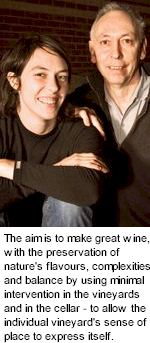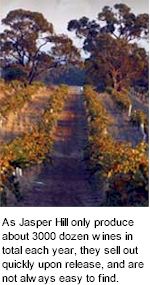


Jasper Hill are produced entirely on the estate using organic/biodynamic principles. The estate produce their own organic compost and have never used synthetic chemicals on either the vines or the soils, since vineyards were planted in 1975. Viticultural practices are as close to nature as possible: own rooted vines (ie. not grafted on to American rootstocks to confer Phylloxera resistance), no irrigation whatsoever, minimal tillage, natural inter-row mulching leading to broad bio-diversity, in turn giving depth and intensity to our wines. Only hand pruning of the vines and hand harvesting of the fruit can allow the human connection to the living soil.

The soils are derived from Cambrian age basaltic rock (500 million years). Quite rare in the world and particularly in Australia, here they are unusually deep (4metre), red coloured, well drained, gravelly loams on undulating hillsides, but with good moisture retention. They occur in a narrow, non-contiguous strip between two naturally occurring North/South faults, typically only a few hundred metres wide. The faults give rise to a complex mineralogy.
Soil organic matter is high, allowing great bio-diversity in micro flora and fauna and supporting large earthworm populations - all beneficial for natural soil fertility. No synthetic chemicals have ever been applied to the soil or vines; the vineyards are totally organic; no insecticides, no herbicides, no synthetic fungicides and no artificial fertilisers.
The soil surface is either covered in mulch derived from vine prunings, leguminous cover crops and native grasses, or is lightly cultivated, with aeration. Minimal tillage is practiced, within and between vine-rows, using lightweight 4WD tractors to minimise soil compaction. Minimal intervention is used during fermentation and maturation, allowing terroir or earth character of the individual paddock or plot to emerge in the wine. More importantly the grapes at harvest are flavour ripe, regardless of sugar ripeness.

The vines have a sunny, open, balanced canopy that keeps fungal diseases at bay and eliminates the need for summer pruning, leaf plucking and crop reduction. All picking and pruning is carried out by hand by wonderfully skilled people from the district. All vineyards are unirrigated and rely on natural rainfall only. Underscoring the quality of the soils, at vintage the grapes retain high levels of natural acidity. Acid adjustment is rarely ever needed, even when sugar levels reach 14 Baume or higher.
Both Emily's and Georgia's Paddocks are on elevated hillsides at an altitude of 320 metres (1000 feet) and are approximately 1 km apart. Emily’s Paddock has a NE aspect and shallower soil, while Georgia’s Paddock has a NW aspect and the deeper soil. The vineyard at Cornella, is 20km north of Emily’s Paddock, within the Heathcote Region and on the same Cambrian soil, with an altitude of 330 meters and a NE aspect. Emily's Paddock is three hectares of Shiraz including around five percent Cabernet Franc, yielding about two tonnes per hectare (14hL per hectare), planted in 1975/76. Georgia's Paddock is twelve hectares of Shiraz yielding about three tonnes per hectare (20hl per hectare). Three hectares of Riesling giving about three tonnes per hectare (20 hL per hectare). Planted in 1975/76 with further small plantings done after the vineyard was ravaged by bushfire in 1987. One hectare each of Semillon planted in 1992, and Nebbiolo planted in 1993. Cornella Vineyard is four hectares of Grenache planted in 1998.
All fermentation is carried out by indigenous (native or wild) yeasts present on the grape skins. All pressings are returned for completeness of the wine. The red wines are then racked off gross lees into small French and American oak barriques (20 percent new each year) for oak maturation of about 15 months with no racking or fining or filtration. Malolactic fermentation occurs naturally in the barrel without any inducement during late spring. After blending, they are given a coarse filtration just prior to bottling on our own state-of-the-art equipment.
